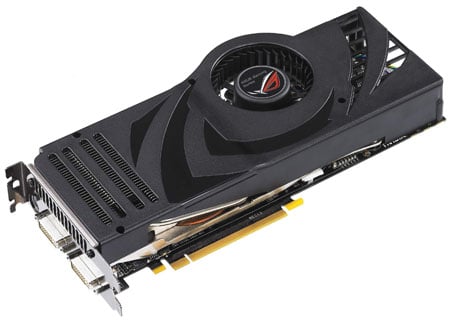This article is more than 1 year old
Asus EN8800 Nvidia GeForce 8800 Ultra-based graphics card
AMD who?
Tragically, the demo was posted a day after Asus had reclaimed its graphics card from our grasp after a very short loan period so we can't yet comment on the looks or performance of the demo on the Ultra. We can report, however, that the demo looked awful on AMD's ATI Radeon HD 2900 XT, so it's probably best if we pass on AMD's thoughts on the subject:
"Lost Planet is an Nvidia-sponsored title, and one that Nvidia has had a chance to look at and optimise their drivers for. The developer has not made [AMD] aware of this new benchmark, and as such the ATI Radeon driver team has not had the opportunity to explore how the benchmark uses our hardware and optimise in a similar fashion."
The reason for the short loan period is simple to explain. The 8800 Ultra is very expensive and samples are few and far between. At launch, Nvidia had just two cards available for the UK's entire array of technology correspondents, and we get the impression that Asus has only one EN8800 Ultra doing the rounds.

Asus' EN8800 Ultra graphics card
So what, you may wonder, do you get for an extra £100 over the price of a regular GeForce 8800 GTX? The core speed is raised from 575MHz to 612MHz, the Stream processors run at 1500MHz instead of 1350MHz, and the memory has an effective speed of 2160MHz rather than 1800MHz. In other words, the Ultra is a carefully selected GTX that runs approximately ten per cent faster than normal.
The other thing that sets the Ultra apart is the layout of the heatsink package. The GTS and GTX use a conventional double-slot design that transfers heat from the heatsink to the heat exchanger via an array of heatpipes. The cooling fan sits between the heat exchanger and the pair of PCI Express power connectors where it can suck air in from inside the case and then blow it through the heat exchanger. It's a logical arrangement. However, it means that the fan unit is located directly above the power hardware, and that's not an especially good location. With the Ultra the fan has been moved sideways where it's out of the way, hence the bulge in the plastic shroud which covers the entire length of the graphics card.
This simple change helps to keep the Ultra cool despite its maximum power draw of 175W. In 2D usage, the cooler is essentially silent but the real surprise is that the cooler barely gets any louder even when the Ultra is working hard. This is an impressive feat by any standards.
